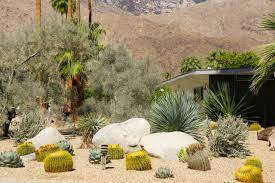Xeriscaping, a landscaping approach that emphasizes water conservation and sustainability, has gained popularity as an eco-friendly alternative to traditional gardening. Derived from the Greek word “xeros,” meaning dry, xeriscaping focuses on creating beautiful landscapes with minimal water usage. In this article, we’ll explore the advantages and disadvantages of xeriscaping to help you make informed decisions about implementing this water-wise approach in your outdoor spaces.
Advantages of Xeriscaping:
- Water Conservation: The primary advantage of xeriscaping is its significant contribution to water conservation. By utilizing drought-tolerant plants and efficient irrigation methods, xeriscaped landscapes reduce water consumption, helping homeowners and communities conserve this precious resource.
- Low Maintenance: Xeriscaping often translates to lower maintenance requirements compared to traditional landscapes. Drought-resistant plants typically require less care, reducing the need for frequent watering, mowing, and other time-consuming maintenance tasks. This can save homeowners both time and effort in the long run.
- Cost Savings: With less demand for water and reduced maintenance needs, xeriscaping can lead to substantial cost savings. Homeowners can expect lower water bills, decreased expenses on fertilizers and pesticides, and potentially reduced costs for lawn care services.
- Increased Property Value: Xeriscaped properties are increasingly attractive to environmentally conscious buyers. The investment in water-wise landscaping can enhance the curb appeal of a property, potentially leading to increased property value. This is especially valuable in regions where water conservation and sustainable practices are highly valued.
- Diverse Plant Selection: Xeriscaping allows for a diverse selection of plants that are adapted to arid or semi-arid climates. From succulents and ornamental grasses to native flowers and shrubs, homeowners can create visually appealing landscapes with a wide range of plant choices, fostering biodiversity.
- Environmental Benefits: Xeriscaping positively impacts the environment by reducing water runoff and the need for chemical inputs. Native plants used in xeriscapes often support local ecosystems by providing habitats for wildlife, contributing to overall ecological health.
- Resilience to Drought: The drought-tolerant nature of xeriscaped gardens makes them more resilient during water shortages or drought conditions. Xeriscaped landscapes are better equipped to thrive in challenging environmental conditions, ensuring the longevity and sustainability of the garden.
Disadvantages of Xeriscaping:
- Initial Cost and Effort: Transitioning to xeriscaping may involve an initial investment in new plants, soil amendments, and irrigation systems. While the long-term savings are significant, some homeowners may find the upfront cost and effort to be a potential barrier to adopting xeriscaping.
- Limited Aesthetic Variety: Some individuals may find that xeriscaped landscapes lack the lush greenery and vibrant colors associated with traditional gardens. The focus on drought-tolerant plants, which may have unique shapes and textures but may not provide a traditional floral display, can limit the aesthetic variety for those with specific preferences.
- Learning Curve: Successfully xeriscaping a garden requires a certain level of knowledge about drought-tolerant plant care, soil composition, and irrigation techniques. For those new to xeriscaping, there may be a learning curve in understanding the specific needs of the chosen plants and optimizing the landscape for water efficiency.
- Challenging in Humid Climates: Xeriscaping is typically most effective in arid and semi-arid climates with limited water availability. In humid regions, where water is more abundant, the water-wise principles of xeriscaping may not be as critical, and traditional landscaping methods might be more suitable.
- Perception Challenges: Despite the environmental benefits, some individuals may perceive xeriscaped landscapes as less conventional or aesthetically pleasing. Overcoming societal expectations and promoting the positive aspects of xeriscaping may be necessary to shift public perception.
- Potential for Soil Erosion: In areas with heavy rainfall, xeriscaped gardens may face challenges related to soil erosion. The reduced vegetation cover and reliance on drought-tolerant plants may make the soil more susceptible to erosion during intense storms.
Conclusion:
Xeriscaping offers numerous advantages, particularly in terms of water conservation, cost savings, and environmental sustainability. However, it is essential to consider the potential disadvantages, such as the initial investment, limited aesthetic variety, and the learning curve associated with this landscaping approach. Homeowners must weigh these factors based on their specific needs, local climate conditions, and personal preferences before deciding to embrace xeriscaping for their outdoor spaces.

